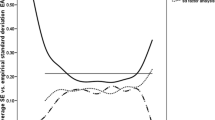Abstract
“Cut points” or “cut scores” play a central role in Jacobson's popular method of identifying clinically significant changes in psychotherapy. When pre- and posttherapy scores of a client are on different sides of one of these cut scores, the change is considered clinically significant, provided that it is also “reliable” (i.e., not due to measurement errors). This article critically examines the meanings and implications of these cut scores. Contrary to popular beliefs, they are generallynot the test scores for which the probability of “belonging” to the Functional population is equal to the probability of “belonging” to the Dysfunctional population. When the Functional population distribution is above that of the Dysfunctional population, persons scoring above these cut scores can, in fact, have much greater probabilities of belonging to the Dysfunctional than to the Functional population. Goals of Jacobson's method can be attained only with Bayesian methods. Bayesian modifications of Jacobson's cut scores are proposed, although their use is limited by the availability of relevant base rates. Bayesian methods (a) can provide information about the probability that an individual belongs to each population, given his (her) score, and (b) are expected to yield total misdiagnosis rates that are many times lower than those of Jacobson's method. Users of Jacobson's method are cautioned against interpreting ratios of likelihoods as if they were ratios of posterior probabilities.
Similar content being viewed by others
References
Ankuta, G. Y., & Abeles, N. (1993). Client satisfaction, clinical significance, and meaningful change in psychotherapy.Professional Psychology: Research and Practice, 24, 70–74.
Christensen, L., & Mendoza, J. L. (1986). A method of assessing change in a single subject: An alternative to the RC Index.Behavior Therapy, 17, 305–308.
Eddy, D. M. (1982). Probabilistic reasoning in clinical medicine: Problems and opportunities. In D. Kahneman, P. Slovic, & A. Tversky (Eds.).Judgement under uncertainty: Heuristics and biases. New York: Cambridge University Press.
Hersh, L. (1995). Adapting to health care reform and managed care: Three strategies for survival and growth.Professional Psychology: Research and Practice, 26, 16–26.
Hsu, L. M. (1988). Fixed versus flexible MMPI diagnostic rules.Journal of Consulting and Clinical Psychology, 56, 458–462.
Hsu, L. M. (1989). Reliable changes in psychotherapy: Taking into account regression toward the mean.Behavioral Assessment, 11, 459–467.
Hsu, L. M. (1995). Regression toward the mean due to measurement error and the identification of improvement and deterioration in psychotherapy.Journal of Consulting and Clinical Psychology, 63, 141–144.
Jacobson, N. S., & Truax, P. (1991). Clinical significance: A statistical approach to defining meaningful change in psychotherapy research.Journal of Consulting and Clinical Psychology, 59, 12–19.
Jacobson, N. S., & Revenstorf, D. (1988). Statistics for assessing the clinical significance of psychotherapy techniques: Issues, problems, and new developments.Behavioral Assessment, 10, 133–145.
Jacobson, N. S., Follette, W. C., & Revenstorf, D. (1984). Psychotherapy outcome research: Methods for reporting variability and evaluating clinical significance.Behavioral Assessment, 15, 336–352.
Jacobson, N. S., Follette, W. C., & Revenstorf, C. (1986). Toward a standard definition of clinically significant change.Behavioral Assessment, 17, 308–311.
Kazdin, A. E. (1982).Research design in clinical psychology. Boston: Ally and Bacon.
Lambert, M. L. (1994). Use of psychological tests for outcome assessment. In M. E. Maruish (Ed.),The use of psychological tests for treatment planning and outcome assessment, pp. 75–97. Hillsdale, NJ: LEA.
Marten, P. A., & Heimberg, R. G. (1995). Toward an integration of independent practice and clinical research.Professional Psychology: Research and Practice, 26, 48–53.
Moreland, K. L., Fowler, R. D., & Honaker, L. M. (1994). Future directions in the use of psychological assessment for treatment planning and outcome assessment: Predictions and recommendations. In M. E. Maruish (Ed.),The use of psychological tests for treatment planning and outcome assessment, pp. 75–97. Hillsdale, NJ: LEA.
Morrison, D. F. (1976).Multivariate statistical methods. New York: McGraw-Hill.
Ogles, B. M., Lambert, M. J., & Sawyer, J. D. (1995). Clinical significance of the National Institute of Mental Health treatment of depression collaborative research program data.Journal of Consulting and Clinical Psychology, 63, 324–326.
Phillips, L. D. (1973).Bayesian statistics for social scientists. New York: Thomas Y. Crowell Company.
Rorer, L. G., Hoffman, P. J., LaForge, G. E., & Hsieh, K. C. (1966). Optimum cutting scores to discriminate groups of unequal size and variance.Journal of Applied Psychology, 50, 153–164.
Saunders, S. M., Howard, K. I., & Newman, F. L. (1988). Evaluating the clinical significance of treatment effects: Norms and normalcy.Behavioral Assessment, 10, 207–218.
Stilson, D. W. (1966).Probability and statistics. San Francisco: Holden-Day.
Wampold, B. E., & Jenson, W. R. (1986). Clinical significance revisited.Behavior Therapy, 17, 302–311.
Widiger, T. A., Hurt, S. W., Frances, A., Clarkin, J. F., & Gilmore, M. (1984). Diagnostic efficiency and DSM-III.Archives of General Psychiatry, 41, 1005–1021.
Author information
Authors and Affiliations
Rights and permissions
About this article
Cite this article
Hsu, L.M. On the identification of clinically significant client changes: Reinterpretation of Jacobson's cut scores. J Psychopathol Behav Assess 18, 371–385 (1996). https://doi.org/10.1007/BF02229141
Accepted:
Issue Date:
DOI: https://doi.org/10.1007/BF02229141



